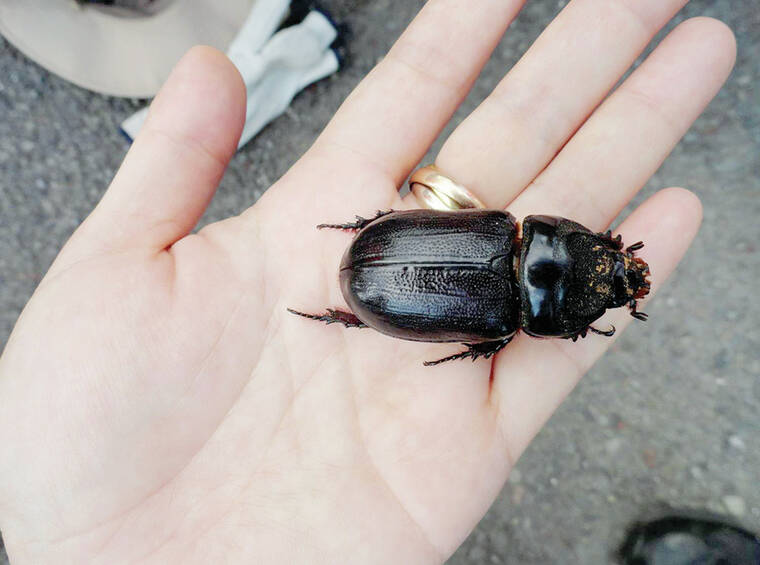LIHU‘E — State officials are rushing to protect Kaua‘i’s palm trees after environmentalists discovered invasive coconut rhinoceros beetles in Lihu‘e — a first for the island.
A survey crew from the Kaua‘i Invasive Species Committee, a University of Hawai‘i-led conservationist project, found the two coconut rhinoceros beetles on May 31 in traps near the Lihu‘e Refuse Transfer Station and Lihu‘e Airport. Two days later, the group found an additional dead beetle in a nearby trap.
First found on O‘ahu in 2013, Kaua‘i is now the only other Hawaiian island known to house the coconut rhinoceros beetle. Native to Southeast Asia, they’ve since spread from Joint Base Pearl Harbor-Hickam throughout much of West O‘ahu, as well as O‘ahu’s North Shore. It is still not known how the beetles first arrived in Hawai‘i.
These beetles bore into the crowns of palm trees, feeding on sap and causing serious harm to the trees. New, unopened fronds are damaged in the process, and when fully opened, may break and fall unexpectedly. If the beetles kill or damage the growing point of the palm, the entire tree may die.
Additionally, wounds caused by the beetle’s bores can become infected by fungi or bacteria, killing the tree as well. Anywhere from 10 to 50 percent of trees attacked by coconut rhinoceros beetles will die, according to the state Department of Agriculture.
In an attempt to stamp out the beetle before it spreads further, the department announced Monday it would expand its incident management system to Kaua‘i after nearly a decade of eradication efforts on O‘ahu.
Additionally, four members of the CRB Response Team — a multiagency group dedicated to combating the spread of coconut rhinoceros beetles — are being deployed to the Garden Island this week to assist.
“When (coconut rhinoceros beetles) were first detected on O‘ahu about 10 years ago, early eradication efforts were hampered by the lack of funding and lack of information about the pest,” said Sharon Hurd, chairperson of the state Board of Agriculture. “We want to make sure this does not happen on Kaua‘i, and we appreciate the assistance of partner agencies and all the research that has gone into eradication and control.”
The response plan for Kaua‘i includes conducting visual surveys, deploying additional traps and reviewing possible pathways in which the beetles could be introduced to uninfested areas. Additionally, fumigation of green waste and deployment of detector dogs are being considered.
Surveillance for coconut rhinoceros beetles has been ongoing on all neighbor islands, including Kaua‘i, where pheromone traps have been used for more than five years in strategic locations at Nawiliwili Harbor and Lihu‘e Airport.
“Much has been learned over the past years about the life cycle, detection, management, containment and treatment protocols,” said Helmuth Rogg, administrator of the state Department of Agriculture’s Plant Industry Division. “With these new detections on Kaua‘i, we are focusing a rapid response toward eradication.”
In an effort to combat the beetle’s spread, the department issued an interim rule in July 2022 restricting the movement of potential coconut rhinoceros beetle host material — including trees, green waste, compost, mulch, trimmings and fruit and vegetable scraps — both within O‘ahu and from O‘ahu to neighbor islands.
Because green waste serves as an optimal breeding environment for coconut rhinoceros beetles, the department urges residents on all islands to check their compost bins and green waste for the beetle’s larvae.
Reports of possible coconut rhinoceros beetle infestation may be addressed to the CRB Response Team at 808-679-5244 or info@crbhawaii.org. Additionally, reports can be submitted to the state’s toll-free Pest Hotline at 808-643-PEST (7378).
•••
Jackson Healy, reporter, can be reached at 808-647-4966 or jhealy@thegardenisland.com.


